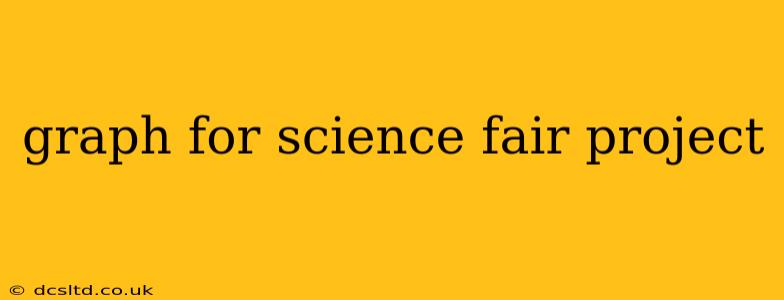Creating a compelling science fair project involves more than just conducting experiments; it requires effectively communicating your findings. A well-chosen and meticulously crafted graph is crucial for visually presenting your data and making your project stand out. This guide will help you select the appropriate graph type and create one that clearly and accurately represents your scientific results.
What Type of Graph Should I Use?
The best graph for your science fair project depends entirely on the type of data you've collected. Here's a breakdown of common graph types and when to use them:
1. Line Graphs:
- Best for: Showing trends and changes over time or across continuous variables. Ideal when you have independent (e.g., time, temperature) and dependent (e.g., plant growth, reaction rate) variables.
- Example: Tracking plant height over a period of weeks, illustrating the growth rate. Showing the change in reaction rate at different temperatures.
- When NOT to use: When comparing distinct categories or showing parts of a whole.
2. Bar Graphs (or Bar Charts):
- Best for: Comparing different categories or groups. Excellent for showing discrete data (data that can be counted).
- Example: Comparing the average height of plants grown under different light conditions. Illustrating the number of plants that survived under various watering schedules.
- When NOT to use: When showing trends over time or continuous data.
3. Pie Charts:
- Best for: Showing the proportion or percentage of different categories within a whole. Useful for visualizing parts of a whole.
- Example: Representing the percentage composition of different soil components. Showing the proportion of students who chose different science projects.
- When NOT to use: When showing trends, changes over time, or comparing large numbers of categories. Avoid using too many slices (more than 6-8 is generally too many).
4. Scatter Plots:
- Best for: Showing the relationship between two variables. Helps identify correlations or trends between the data points.
- Example: Showing the relationship between hours of study and test scores. Illustrating the correlation between plant height and the amount of fertilizer used.
- When NOT to use: When showing distinct categories or parts of a whole.
What are the Key Elements of a Good Science Fair Graph?
Regardless of the type of graph you choose, several key elements ensure clarity and effectiveness:
-
Clear and Concise Title: Your title should accurately reflect the data being presented. For instance, instead of "Plant Growth," a better title would be "The Effect of Sunlight Exposure on the Growth of Sunflower Plants."
-
Labeled Axes: Clearly label both the x-axis (horizontal) and y-axis (vertical) with the variable names and units (e.g., "Time (days)," "Plant Height (cm)").
-
Consistent Scale: Maintain a consistent scale on both axes to avoid misleading representation of the data.
-
Appropriate Data Presentation: Use bars of equal width in bar graphs, clearly marked data points in line and scatter plots, and accurately sized slices in pie charts.
-
Legend (if necessary): If your graph uses multiple datasets or colors, include a legend to clarify what each represents.
-
Neat and Organized Appearance: Ensure your graph is well-spaced, easy to read, and visually appealing.
How Do I Create a Graph for My Science Fair Project?
You can create graphs using various tools:
-
Spreadsheet Software (e.g., Microsoft Excel, Google Sheets): These are excellent options, providing many customization options and automating data plotting.
-
Graphing Calculators: Some graphing calculators have built-in graphing capabilities suitable for simple projects.
-
Online Graphing Tools: Numerous free online tools allow you to create graphs without needing specialized software.
How Do I Interpret the Data Shown in My Graph?
After creating your graph, carefully analyze the data it represents. Look for trends, patterns, and significant differences. These observations will form the basis of your conclusions and discussion in your science fair project. Be sure to relate your findings back to your hypothesis.
Frequently Asked Questions (FAQ)
What's the difference between a bar graph and a histogram?
A bar graph compares different categories, while a histogram displays the frequency distribution of a continuous variable. Histograms have bars touching each other, unlike bar graphs, which have gaps between bars.
Can I use more than one type of graph in my science fair project?
Yes, if your data requires it, you can use multiple graphs to present your findings more effectively. For example, you might use a line graph to show a trend over time and a bar graph to compare different conditions.
What is the best software to create graphs for a science fair project?
Microsoft Excel and Google Sheets are popular and widely accessible choices offering powerful graphing capabilities. However, many free online tools are also available.
How many data points should I have for a graph?
The number of data points depends on your experiment, but generally, more data points lead to more reliable results and a clearer representation of the trends. Aim for a sufficient number to support your conclusions. Avoid over-cluttering your graph with too many data points.
By following these guidelines and choosing the appropriate graph type, you'll be able to effectively communicate your scientific findings and create a standout science fair project. Remember to always present your data accurately and ethically.
